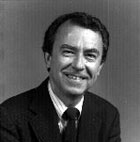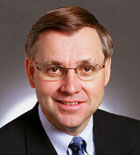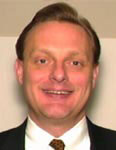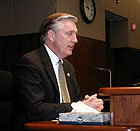By MPR Newsroom
Minnesota Public Radio
April 11, 2002
A one-day summit at the Hubert H. Humphrey Institute of Public Affairs. Produced by Minnesota Public Radio, the Humphrey Institute, Center for Transportation Studies at the University of Minnesota, and the Minnesota Historical Society.
The Getting There summit is a gathering of some 70 stakeholders to discuss transportation issues facing Minnesota. The participants develop transportation visions for improving congestion, safety, access, the environment and return on money spent. They also build action steps to help make those visions become realities.
Agenda
Hour One: How Did We Get Here and Where Are We Headed?
![]()
John S. Adams, professor, geography department, University of Minnesota
Pat Awada, mayor, Eagan
Sen. Dean Johnson, DFL-Willmar
Curt Johnson, consultant, former Metropolitan Council chair
Hour Two - A Call To Action: What Must Get Done Nationally, Statewide, Regionally
![]()
National - Cindy Burbank, manager of planning, environment and real estate services, Federal Highway Administration
State - Elwyn Tinklenberg, commissioner, Minnesota Department of Transportation
Regional - Ted Mondale, chair, Metropolitan Council
Watch this site for a downloadable final summit report published by the Humphrey Institute.
Panelists
| |
|
|
|
||
John S. Adams, who holds the Fesler-Lambert Chair in Urban and Regional Affairs, is a faculty member at the Humphrey Institute. He researches issues relating to North American cities, urban housing markets and housing policy, and regional economic development in the United States and the former Soviet Union. He has been a National Science Foundation Research Fellow at the Institute of Urban and Regional Development, University of California at Berkeley, and economic geographer in residence at the Bank of America World Headquarters in San Francisco. He was senior Fulbright Lecturer at the Institute for Raumordnung at the Economic University in Vienna and was on the geography faculty of Moscow State University. He has taught at Pennsylvania State University, the University of Washington, and the U.S. Military Academy at West Point. His most recent book, Minneapolis-St. Paul: People, Place, and Public Life, looks at the region's growth and at what factors may affect the metropolitan area's future. Adams holds two degree in economics and a doctorate in urban geography from the University of Minnesota.
| |
|
|
|
||
Sen. Dean Johnson, DFL-Wilmar, is chair of the Senate's Transportation and Public Safety Budget Division. He was elected to the Minnesota State Senate in 1982 and has served in the Senate since then. He also served in the Minnesota House and the Wilmar City Council. He has been a full-time pastor at Calvary Lutheran Church in Willmar, Minnesota for five years and part-time for 24 years. He is the state chaplain in the Minnesota Army National Guard with the rank of colonel.
Curtis Johnson's career has been split between action and analysis - on the one side as a leader in governance, culminating with four years as chairman of the Metropolitan Council in the Twin Cities (Minnesota) and on the other as an independent journalist and commentator on urban and metropolitan issues in regions around America and the world. Johnson's Minnesota experience includes 10 years as a community college president in the 1970s, followed by 11 years as the head of the Citizens League, during which time he became a familiar face and voice in local media.
In the early 1990s he served on former Gov. Arne Carlson's staff as senior policy adviser and later chief of staff. Since the mid-1980s, he has co-authored with columnist Neal Peirce a set of major articles on strategic regional issues for newspapers in 21 metropolitan areas, most recently for South Florida and South Texas. He and Peirce wrote two books in the '90s: Citistates: How Urban America Can Prosper in a Competitive World, and Boundary Crossers.
| |
|
|
|
||
Ted Mondale is chair of the Metropolitan Council. He is a former Minnesota senator and candidate for governor. He has served as a member of the Democratic Leadership Council, a Public Policy Institute's New Economy Task Force member and has been a member of the Alliance for Global Competitiveness. He is author of the book, A New Commitment to Minnesota Families, and was honored as one of the top 40 business and community leaders under 40 years old by CityBusiness: The Business Journal.
Cynthia J. Burbank is program manager for planning, environment, and right of way with the Federal Highway Administration. She has worked for the U.S. Department of Transportation for 27 years. She supervises more than 100 engineers, environmental scientists, transportation specialists, planners, and staff. She oversees Federal regulations and policies for the acquisition of real property by all Federal agencies; FHWA's statewide, intermodal, and metropolitan planning programs; and FHWA environmental programs. Twice a recipient of the DOT Silver Medal, Ms. Burbank was awarded the Meritorious Executive Award in 1997. She received the Woman of the Year award from the Women’s Transportation Seminar for 2001. A native of Vermont, she attended Duke University, Boston University, and graduated from Georgetown University, with a degree in economics, Phi Beta Kappa and Magna Cum Laude.
| |
|
|
|
||
Elwyn G. Tinklenberg was appointed commissioner of the Minnesota Department of Transportation by Gov. Jesse Ventura in January 1999. He had specialized in public affairs with Goff & Howard and operated a consulting firm specializing in transportation. Before that he was employed by Anoka County for 11 years, Tinklenberg served 14 years on the Blaine City Council including 10 years as mayor from 1986 until 1996. He was president of the North Metro Mayors Association from 1990 until 1996 and led the North Metro Crossing coalition, a transportation advocacy group, from 1990 until 1994. He was instrumental in creation of the Northstar Corridor Development Authority between Minneapolis and St. Cloud and in the planning for the commuter rail demonstration event in July 1997.
Pat Anderson Awada was first elected to Eagan's City Council in 1991, she served two terms before being elected in 1998 as mayor of Minnesota's 8th largest city. As mayor of Eagan, Pat represents nearly 64,000 citizens. She testifies regularly before the Minnesota Legislature on matters involving local government finance, and is viewed as one of the most outspoken proponents of local government control. In addition to her mayoral duties, Pat owns two successful businesses that she created in 1994. With only a computer and a printer, she started a one-person shop, and turned it into a successful multi-million dollar business that currently employs nearly 50 people. A Minnesota native, she graduated from the University of Minnesota in with a degree in International Relations, and later earned her M.A. in Public Administration from Hamline University.




